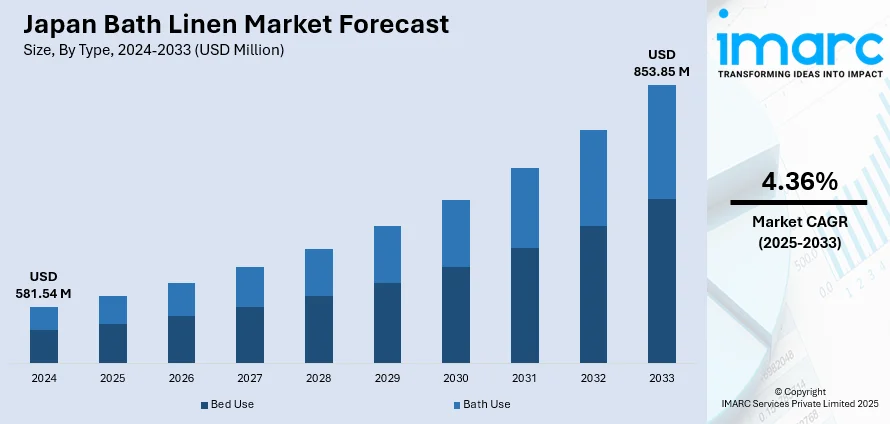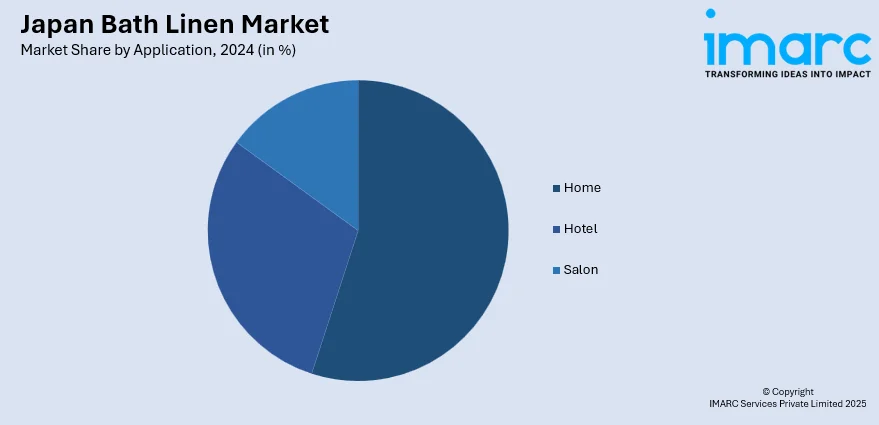
Japan Bath Linen Market Size, Share, Trends and Forecast by Type, Application, and Region, 2025-2033
Japan Bath Linen Market Overview:
The Japan bath linen market size reached USD 581.54 Million in 2024. Looking forward, IMARC Group expects the market to reach USD 853.85 Million by 2033, exhibiting a growth rate (CAGR) of 4.36% during 2025-2033. The market is experiencing steady growth as consumers prioritize premium, sustainable, and comfortable products for their bathrooms. Innovations in fabric technology, increased demand for eco-friendly materials, and rising disposable income. As lifestyle trends evolve, the market continues to expand with a focus on luxury and functionality, further supporting the Japan bath linen market share.
|
Report Attribute
|
Key Statistics
|
|---|---|
|
Base Year
|
2024 |
|
Forecast Years
|
2025-2033
|
|
Historical Years
|
2019-2024
|
| Market Size in 2024 | USD 581.54 Million |
| Market Forecast in 2033 | USD 853.85 Million |
| Market Growth Rate 2025-2033 | 4.36% |
Japan Bath Linen Market Trends:
Aging Population and Health Consciousness
Japan’s rapidly aging population significantly influences consumer behavior in the bath linen market. Seniors are concerned about comfort, hygiene, and wellness, which drives the need for top-quality, skin-friendly, and functional bath linens. Products with antibacterial, hypoallergenic and quick drying properties are more often chosen to ensure hygiene and avoid skin irritation. Furthermore, luxury or therapeutic bath linens also become the purchase of choice for seniors, including those made from organic cotton or special textures that provide a relaxing experience. The strong purchasing commitment of this demographic provides for long-term demand for premium products. With aging individuals looking for more accessible and convenient self-care practices, advances such as easy-dry towels or bath mats with an anti-slip feature are gaining popularity. Overall, the aging society in Japan shapes a market increasingly focused on comfort, safety, and hygiene, driving both product innovation and premiumization.

Emphasis on Quality and Craftsmanship
Japanese consumers traditionally value superior quality, craftsmanship, and attention to detail, which directly impacts the bath linen market. Buyers are often willing to pay a premium for products made from natural fibers like organic cotton, bamboo, or linen, especially those manufactured with eco-friendly or traditional methods. Brands that emphasize Japanese textile heritage, such as Imabari towels, known for softness and high absorbency, perform exceptionally well. This quality-focused culture means that durability, comfort, and aesthetic appeal matter greatly. Consumers conduct detailed comparisons and prefer established domestic or artisanal brands over cheaper imports. As a result, bath linen manufacturers in Japan focus on continuous improvement, sustainable practices, and maintaining high standards in both design and functionality to meet evolving customer expectations and justify higher price points.
Eco-Conscious Consumer Behavior
Environmental awareness is a growing factor in Japanese consumer choices, strongly influencing the Japan bath linen market growth. Consumers increasingly prefer eco-friendly, sustainable, and ethically produced products. This shift supports demand for organic cotton, bamboo fabrics, and textiles dyed with natural or low-impact dyes. Brands that emphasize reduced water usage, biodegradable packaging, and carbon-neutral manufacturing gain favor among environmentally conscious buyers. Recycling initiatives and circular economy practices are also beginning to affect purchasing decisions, with some consumers opting for brands that offer towel recycling or trade-in programs. As Japan aligns more with global sustainability goals, companies are expected to adopt green certifications and transparent sourcing practices. The market is moving toward a balance between luxury and sustainability, with eco-luxury emerging as a desirable niche for modern Japanese consumers.
Japan Bath Linen Market Segmentation:
IMARC Group provides an analysis of the key trends in each segment of the market, along with forecasts at the country and regional levels for 2025-2033. Our report has categorized the market based on type and application.
Type Insights:
- Bed Use
- Bath Use
The report has provided a detailed breakup and analysis of the market based on the type. This includes bed use and bath use.
Application Insights:

- Home
- Hotel
- Salon
A detailed breakup and analysis of the market based on the application have also been provided in the report. This includes home, hotel, and salon.
Regional Insights:
- Kanto Region
- Kansai/Kinki Region
- Central/ Chubu Region
- Kyushu-Okinawa Region
- Tohoku Region
- Chugoku Region
- Hokkaido Region
- Shikoku Region
The report has also provided a comprehensive analysis of all the major regional markets, which include the Kanto Region, Kansai/Kinki Region, Central/ Chubu Region, Kyushu-Okinawa Region, Tohoku Region, Chugoku Region, Hokkaido Region, and Shikoku Region.
Competitive Landscape:
The market research report has also provided a comprehensive analysis of the competitive landscape. Competitive analysis such as market structure, key player positioning, top winning strategies, competitive dashboard, and company evaluation quadrant has been covered in the report. Also, detailed profiles of all major companies have been provided.
Japan Bath Linen Market Report Coverage:
| Report Features | Details |
|---|---|
| Base Year of the Analysis | 2024 |
| Historical Period | 2019-2024 |
| Forecast Period | 2025-2033 |
| Units | Million USD |
| Scope of the Report |
Exploration of Historical Trends and Market Outlook, Industry Catalysts and Challenges, Segment-Wise Historical and Future Market Assessment:
|
| Types Covered | Bed Use, Bath Use |
| Applications Covered | Home, Hotel, Salon |
| Regions Covered | Kanto Region, Kansai/Kinki Region, Central/ Chubu Region, Kyushu-Okinawa Region, Tohoku Region, Chugoku Region, Hokkaido Region, Shikoku Region |
| Customization Scope | 10% Free Customization |
| Post-Sale Analyst Support | 10-12 Weeks |
| Delivery Format | PDF and Excel through Email (We can also provide the editable version of the report in PPT/Word format on special request) |
Key Questions Answered in This Report:
- How has the Japan bath linen market performed so far and how will it perform in the coming years?
- What is the breakup of the Japan bath linen market on the basis of type?
- What is the breakup of the Japan bath linen market on the basis of application?
- What is the breakup of the Japan bath linen market on the basis of region?
- What are the various stages in the value chain of the Japan bath linen market?
- What are the key driving factors and challenges in the Japan bath linen market?
- What is the structure of the Japan bath linen market and who are the key players?
- What is the degree of competition in the Japan bath linen market?
Key Benefits for Stakeholders:
- IMARC’s industry report offers a comprehensive quantitative analysis of various market segments, historical and current market trends, market forecasts, and dynamics of the Japan bath linen market from 2019-2033.
- The research report provides the latest information on the market drivers, challenges, and opportunities in the Japan bath linen market.
- Porter's five forces analysis assist stakeholders in assessing the impact of new entrants, competitive rivalry, supplier power, buyer power, and the threat of substitution. It helps stakeholders to analyze the level of competition within the Japan bath linen industry and its attractiveness.
- Competitive landscape allows stakeholders to understand their competitive environment and provides an insight into the current positions of key players in the market.
Need more help?
- Speak to our experienced analysts for insights on the current market scenarios.
- Include additional segments and countries to customize the report as per your requirement.
- Gain an unparalleled competitive advantage in your domain by understanding how to utilize the report and positively impacting your operations and revenue.
- For further assistance, please connect with our analysts.
 Request Customization
Request Customization
 Speak to an Analyst
Speak to an Analyst
 Request Brochure
Request Brochure
 Inquire Before Buying
Inquire Before Buying




.webp)




.webp)












